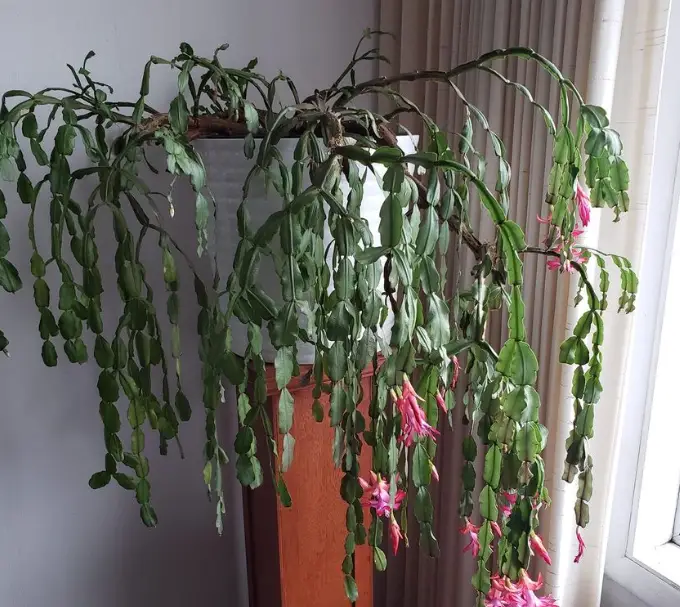100 Year Old Christmas Cactus – Testimony
As the holiday season approaches, many people decorate their homes with beautiful plants that remind them of the festive moments. Christmas cactus is one of the plants at the top of the list. These plants are known for their vibrant blooms, easy maintenance, and longer lifespan.
The Christmas cactus ( Schlumbergera bridgesii), is native to the tropical rainforests of Brazil. Unlike most cacti, which thrive in hot, dry environments, this forest cactus prefers cooler and humid conditions.
In winter, it produces beautiful flowers in shades of pink, red, and white. The secrete to get a Christmas cactus to bloom is to keep it in uninterrupted darkness for 12 to 14 hours daily for six to eight weeks. Then the plant is taken back to its brighter location once the flower buds have formed.

100-year-old Christmas cactus
While these plants typically live for 20-30 years, some hardier varieties may survive and thrive for decades or even centuries. One particular Christmas cactus from a family in Pennsylvania has gained quite a bit of attention for its age – 100 years old.
This 100-year-old Christmas cactus has been passed down through generations of the family. The cactus was originally given as a gift to the owner’s great-grandmother in 1920, making it over a century old.
Over the years, the cactus has survived many moves, including a journey from Pennsylvania to Florida and back again.
Despite its age, this 100-year-old holiday cactus is still going strong. In fact, it continues to produce beautiful blooms every holiday season. Daniella, the plant’s owner, attributes its longevity to careful maintenance and attention to detail when it appears stressed.
Care and maintenance
So what’s the secret to keeping a Christmas cactus alive and thriving for so long? This is a question I asked her, and she went ahead to give insights on how she cares for the cactus to remain healthy and keep producing blooms year after year. Here is what she said:
Providing the right care is important to keep a Christmas cactus healthy and thriving. These plants prefer well-drained soil that is kept slightly moist. Overwatering can cause the roots to rot, so letting the soil dry out slightly between waterings is important.
This reminded me of my overwatered Christmas cactus back when I was a starter. I never knew that watering before the soil dries out makes the soil waterlogged. And as a result, the roots aren’t able to get oxygen as needed, which makes them suffocate and die.
She went ahead to explain that Christmas cacti can be sensitive to changes in light and temperature. They prefer bright indirect light and cooler temperatures, around 60-70°F (15-21°C). An east or west-facing window can be the ideal spot for the plant.
She also revealed that regular fertilization could help keep the plant healthy for more blooming. Additionally, keeping the plant in a stable environment, free from sudden changes in temperature or light, can help prevent flower buds from falling off.
Daniela cautioned against keeping the plant near cold drafts or heat sources, especially when it’s blooming.
Older Christmas cactus challenges
I was also curious whether she had problems caring for this monstrous plant. Daniela smiled and said it’s completely hard to avoid dealing with a few Christmas cactus diseases and problems.
It was during summer when she was invited for a safari in Africa by one of her friends. Although she left her plant with her new domestic manager, she forgot to give her clear instructions on treating the old family’s treasure.
After a month away, she came back and found her Christmas cactus turning red. This didn’t settle well with her, and she had to seek the help of a plant specialist. From the observation, it was a severe cactus sunburn. The helper has taken the plant outside for warmth but forgot to protect it from direct sunlight.
There was a day Daniela also overfertilized the plant. She missed the point while mixing the fertilizer for her plant. In a few weeks, it was growing more dense but spindly. Unfortunately, the old Christmas cactus woody stems started splitting apart due to the weighty branches.
She quickly pruned the excess foliage, and this helped save the plant. Daniela is a genius at indoor gardening; whenever she pruned the cactus, she propagated the cuttings to get more plants for her collection. This answered why she had so many Christmas cactus plants in her home.
The Christmas cactus root rot is another major challenge. Waterlogged soils mainly cause it. Overcrowding the plants can also encourage pests and also bacterial and fungal infections. Regular monitoring is essential and can help save a plant when it’s in a problem.
Final Thought
If you’re lucky enough to have a Christmas cactus that’s been in your family for years, consider it a special and treasured part of your family’s history. With proper care and attention, your plant may continue to thrive for many generations to come.
My name is Diane M Lewik, and I am the founder of this website. I am a degree holder in plant biology from the University of California – Berkeley. Over the years, I have cultivated a vast collection of succulents and I have learned a great deal about how to grow and care for these unique plants. Feel free to ask any questions in the comment section below.





